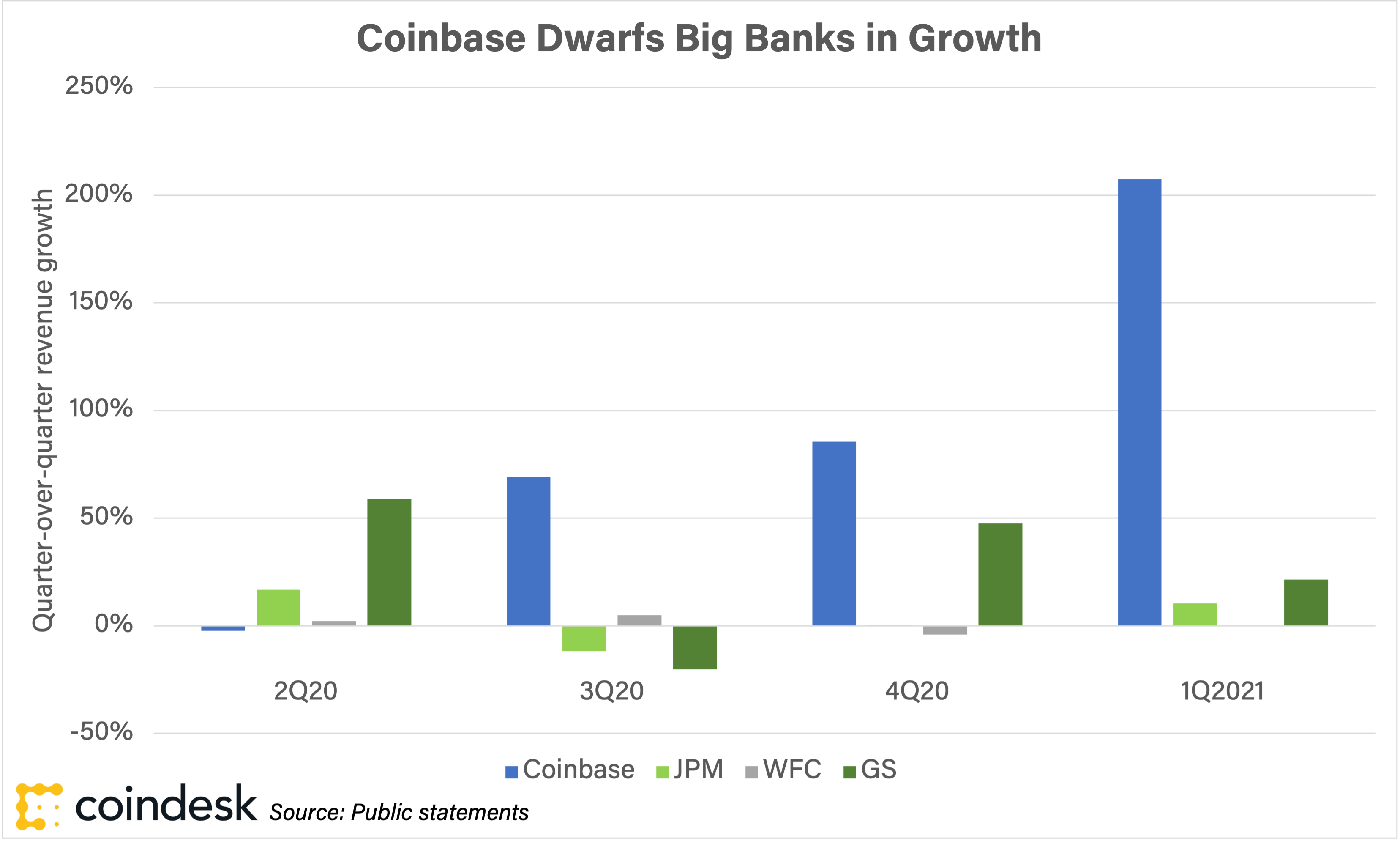The price of Coinbase's direct listing must be eye-popping for investors who watch equities closely but haven't spent a lot of time with crypto assets.
One equities fundamentals analyst, speaking on CoinDesk TV Thursday, estimated Coinbase's true value at approximately more like $50 per share. (Coinbase closed its first full day of trading at $328.)
There are three reasons why investors might be willing to pay a price that represents such a high premium over what Coinbase's fundamentals might seem to command. The first suggests the word "exchange" isn’t a good descriptor of Coinbase’s business. The second looks at Coinbase's growth. The third looks at Coinbase as a passive, diversified investment in crypto assets.
Coinbase is not an exchange
First, it's important to get away from comparing Coinbase to equities exchanges. Coinbase isn't an "exchange," at least not in the sense that the word is used to describe the Nasdaq or the NYSE.
In addition to matching buy and sell orders, Coinbase and other crypto "exchanges" operate custodian and prime-brokerage businesses, serving a mixture of retail and institutional clients. Unlike the NYSE or the Nasdaq, these exchanges give retail users direct access to the order book. In the future – through decentralized finance (DeFi), staking and governance protocols – crypto exchanges like Coinbase can be expected to manage a growing portfolio of services related to lending, borrowing, fixed-income and even governance.
So, what’s a better analogy? I think it's fair to look at Coinbase as a neobank. But rather than offering a retail banking bundle of services on a new delivery mechanism, crypto exchanges like Coinbase are offering a big-bank bundle of services on a new financial paradigm.
Conveniently for this analogy, JPMorgan, Wells Fargo and Goldman Sachs, three of the biggest banks in existence, happened to report quarterly earnings on Wednesday, the same day as Coinbase's listing.

The bar graphs don’t lie: When it comes to revenue, Coinbase's $1.8 billion in Q1 2021 is barely visible compared with that of the big banks. This is despite a market cap that, at times on its first day of trading, rivaled the smallest of these, Goldman, which is valued at around $117 billion.
But please don't read too much into this chart. It reminds me of something you often hear about hyped tech initial public offerings (IPO): "They're not even profitable," people will say.
Nasdaq IPOs are not valued on profit or on revenue, they're valued on growth. They're bought based on an expectation of what will happen next year, not based on what happened last year.
On growth, Coinbase flips the narrative against the bulge bracket

The growth chart flips the Coinbase narrative. In this chart, it's Coinbase that looks like the giant while the big banks look diminutive. So even on growth alone you might give Coinbase a premium, keeping in mind, of course, that big growth on small dollars is still small dollars. Coinbase will have to sustain these growth rates for a long time before its revenue will compare to the bulge bracket.
To believe that it will, you have to believe Coinbase may be poised to ride a paradigm shift in finance. In that light, a valuation north of $60 billion begins to make more sense.
Demand for a diversified, passive crypto investment opportunity
Still, one question any investor should be asking is, will Coinbase simply track the price of bitcoin? In other words, why buy Coinbase when bitcoin is available? The answer is the crypto market tends to vacillate between cycles in which bitcoin is driving momentum and cycles in which alternative coins are driving momentum. Right now it's altcoin season, and some may see Coinbase as a way to spread their bet beyond bitcoin.

Coinbase revenue vs. bitcoin price (quarterly chart)
This chart shows Coinbase's revenue growth each quarter alongside bitcoin's quarterly returns. It's an apples-to-oranges comparison, but it gives a sense of how bitcoin and Coinbase, like bitcoin and altcoins, can trade momentum periods back and forth. There are quarters in which Coinbase revenue growth outpaces bitcoin's price appreciation and vice versa.
Coinbase's revenues come from a mix of bitcoin- and altcoin-related drivers. This makes Coinbase, as others have observed and the chart above proves, a diversified investment on the crypto space.
Diversified, passive opportunities in crypto are not common. But the category's volatility, complexity and sheer novelty make a passive approach a natural fit. Coinbase's premium is, in part, a signal of investors' desire for such opportunities.
DISCLOSURE
Please note that our privacy policy, terms of use, cookies, and do not sell my personal information has been updated.
The leader in news and information on cryptocurrency, digital assets and the future of money, CoinDesk is a media outlet that strives for the highest journalistic standards and abides by a strict set of editorial policies. CoinDesk is an independent operating subsidiary of Digital Currency Group, which invests in cryptocurrencies and blockchain startups. As part of their compensation, certain CoinDesk employees, including editorial employees, may receive exposure to DCG equity in the form of stock appreciation rights, which vest over a multi-year period. CoinDesk journalists are not allowed to purchase stock outright in DCG.
:format(jpg)/cloudfront-us-east-1.images.arcpublishing.com/coindesk/747URFGJWVES5JSIMXQVZZ5DEQ.png)

:format(jpg)/cloudfront-us-east-1.images.arcpublishing.com/coindesk/PFEHNV7HU5CCPFROJKQIPWNYJU.jpg)
:format(jpg)/cloudfront-us-east-1.images.arcpublishing.com/coindesk/YLVK7NL7PJAVRJVREC7DTR6XME.jpg)
:format(jpg)/cloudfront-us-east-1.images.arcpublishing.com/coindesk/EXPOIBREMFHSHA7CVOGJ5TDWUY.jpg)
:format(jpg)/cloudfront-us-east-1.images.arcpublishing.com/coindesk/PJTR3KRDWJCRVE3QREM6KUOK7A.png)